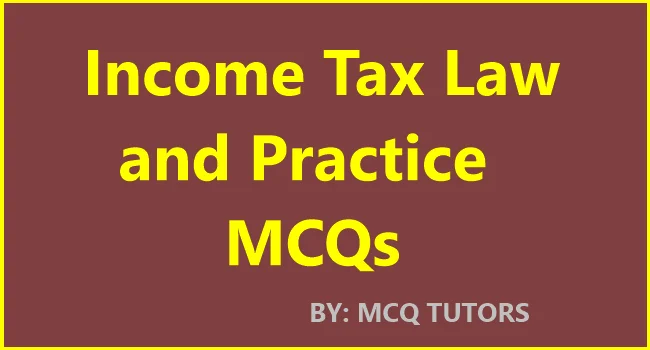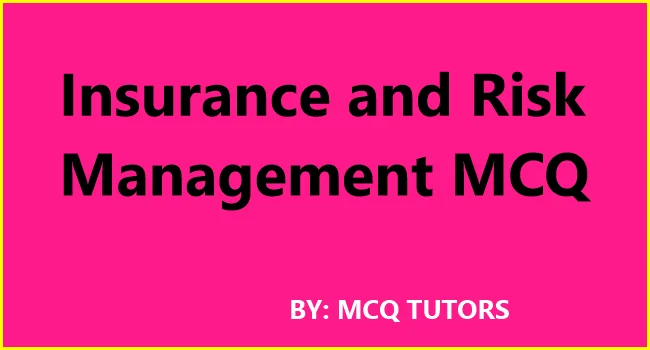Income Tax Law and Practice MCQ Questions with Answers are useful for the preparation of academic and competitive examinations.
Are you preparing for an exam that requires a knowledge of Income Tax Law and Practice MCQs? If so, you have come to the right place!
Additionally, you will be able to take practice quizzes in order to test your understanding of the topics covered.
Income Tax Law and Practice MCQ with Answers
Q1. ENIAC stands for ___
a. Easy Numerical integrator and calculator
b. Electronic Number interface and calculator
c. Electronic Numerical integrator and calculator
d. Electronic Numerical interface and circuit
Ans: c
Q2. The World’s first computer-specific statute was enacted in ___ by the German Status, in the form of a Data Protection Act.
a. 1976
b. 1990
c. 1970
d. 1981
Ans: c
Q3. The film ___ is claimed to be the first movie to exist purely within a digital environment.
a. Avtaar
b. Toy story 2
c. 2012
d. Roadside Romeo
Ans: b
Q4. Cyberspace term was coined by ___
a. Griffin
b. William john
c. William Gibson
d. Dennis
Ans: c
Q5. Laws relating to broadcasting, the medial data protection ___ have a role to play as do provisions of criminal law.
a. evidence
b. contract
c. defamation and intellectual property
d. all of the above
Ans: d
Q6. The first artificial satellite ___ was launched in 1957 to great consternation in the US defense establishment.
a. AGNI-III
b. AFNI-II
c. AGNI-I
d. sputnik
Ans: d
Q7. ARPA stands for
a. Automatic Research Projects Access
b. Advanced Research Projects Agency
c. Automatic Research Projects Animated
d. Advanced Resource Periodic Agency
Ans: b
Q8. E-commerce is a new way of conducting, managing, and executing business transactions using modern information technology.
a. True
b. False
Ans: a
Q9. WTO means ___
a. World trade organization
b. World tactic office
c. Work trade organization
d. Work time office
Ans: a
Q10. E-commerce is commerce based on ___
a. bits
b. Kilobytes
c. Megabytes
d. bytes
Ans: d
Q11. The main Instruments of e-commerce that have been recognized by WTO are ___ and the internet
a. telephone
b. Fax & TV
c. Electronic payment and money transfer systems
d. all of the above
Ans: d
Q12. ___ ensures encrypted passage over the internet for the credit card data
a. E-cash
b. Cybercash
c. online pay
d. none of the above
Ans: b
Q13 A new system of credit card transactions over the internet is being currently developed jointly by Visa and MasterCard with technical assistance from the internet information system and cryptology companies like Netscape, IBM it is known as secure electronic transaction
a. True
b. False
Ans: a
Q14. UNCITRAL stands for ___
a. union national commission on international training law’s
b. united nations commission on international trade law’s
c. united nations commission on interactive trading law’s
d. unlimited new commission on interactive training law’s
Ans: b
Q15. WIPO means ___
a. world intellectual property organization
b. wide intelligent property organization
c. weak interactive periodic organization
d. world interactive periodic organization
Ans: a
Q16. cyberlaw is not important as it touches almost all aspects of transactions and activities concerning the internet the world wide web and cyberlaw
a. True
b. False
Ans: b
Q17. Computer network means the interconnection of one or more computers through the use of ___
a. satellite
b. microwave
c. terrestrial line and communication media
d. all of the above
Ans: d
Q18.short title extent commencement and application act this act may be called the information technology act 2000
a. Correct
b. Incorrect
Ans: b
Q19. “computer crimes” refers to all crimes done through involving or impacting any
a. computer
b. computer system
c. computer network
d. all of the above
Ans: d
Q20. Cybercrime refers to all the activities done with criminal intent in cyberspace or using the medium of the internet.
a. True
b. False
Ans: b
Q21. ___ and harassment are problems that many persons especially women are familiar with within real-life
a. mental torture
b. cyberstalking
c. stalking
d. both 2 and 3 are correct
Ans: d
Q22. The agreement that creates ___ obligations only are contracts
a) Relationship
b) Illegal
c) Legal
d) None of the above
Q23 ___ warranties mean In every contract of sale there is an implied warranty that the buyer shall have enjoy quiet possession of goods
a. Applied
b. Implied
c. supplied
d. all of the above
Ans: b
Q24. The “term of trade” of a country is influenced by factors ___
a. Effect of tariff
b. Effect of devaluation
c. Effect of capital movement and transfer of capital
d. all of the above are correct
Ans: d
Q25. The main objectives of imposing trade barriers are ___
a. To protect domestic industries from foreign competition
b. To guard against dumping
c. To promote indigenous research
d. all of the above
Ans: d
Q26. Export license means export of some of the items are banned and some of the items are permitted to be exported freely
a. True
b. False
Ans: a
Q27. The export should arrange for pre-shipment finance from the banks or financial institutions depending on his financial needs
a. Correct
b. Incorrect
Ans: a
Q28. Negotiate all the Shipping Documents, including those relating to sales on a consignment basis through authorized dealers
a. valid
b. Invalid
Ans: a
Q29. ___ procedures are provided to make the electronic records and digital signatures secured.
a. Law
b. security
c. protected
d. all of the above
Ans: b
Q30 Issuance of ___ certificates by certifying authorities is regulated by subscribers to digital signatures are required to full fill certain obligation and avail the benefits of law
a. signature
b. digital signature
c. all of the above
d. none of the above
Ans: b
Q31. Digital Signature Is Deemed To Be A Secure Signature
a. True
b. False
Ans: a
Q32. Intermediary means ___
a. person
b. place
c. Electronic transfer
d. all of the above
Ans: a
Q33. EDI stands for ___
a. Electronic data interface
b. engineering data interchange
c. electronic data interchange
d. electronic digital interchange
Ans: c
Q34. E-mail is considered a legal document according to cyber law
a. True
b. False
Ans: a
Q35. The trade and Merchandise marks act states the type of trademarks that may be ___
a. registered.
b. known
c. valid trademarks
d. All trademarks
Ans: d
Q36.UNCITRAL model law on electronic commerce in ___ with the objective to provide a common legal platform to the countries to model their domestic laws relating to electronic commerce.
a. 1991
b. 1990
c. 1996
d. 1998
Ans: c
Q37. Sale or exchange of goods and services within a country is not called Internal trade
a. True
b. False
Ans: b
Q38. The activities that take place beyond the political borders or geographical boundaries of a country are called International trade
a. True
b. False
Ans: a
Q39. The ___ the patent office has published notices on ‘Practice on Trademarks incorporating the word Net ‘ and on ‘Registration of Internet Domain names as Trade marks’
a. India
b. UK
c. Australia
d. Paris
Ans: b
Q40. Apple and Microsoft both are registered trademarks
a. Yes
b. No
Ans: a
Insurance and Risk Management MCQ
Q41. Sale or exchange of goods and services within a country is called ___ trade whereas the activities that take place beyond the political borders or geographical boundaries of a country is called ___ trade
a. Internal international
b. external national
c. External international
d Internal National
Ans: a
Qs42. ___ license means export of some of the items are ___ and some of the items are permitted to be exported freely
a. Export banned
b. Import restricted
c. Export renewed
d. Import allowed
Ans: a
Q43. The term ___, ___ service is defined in the document ‘Europe’s way to the information society an action plan’ as encompassing ‘ the various services while will be carried on the information super high ways’
a. ‘Information Society Service’
b. Database system
c. On-line, off-line system
d. Centralize system
Ans: a
Q44. The first artificial satellite, Sputnik was launched in ___ to great consternation in the ___ defense establishment
a. 1957, India
b. 1991, Europe
c. 1957, US
d. 1999, India
Ans: c
Q45. The word ___ was coined by William Gibson in his science fiction novel Necromancer published in ___.
a. information technology, 1991
b. cyberspace, 1984
c. virtual location, 1990
d. electronic media, 1993
Ans: b
Q46. “Court “ includes all ___ and ___ and persons, except arbitrators, legally authorized to take evidence.
a. Lawyers, Magistrates
b. Judges, Magistrates
c. Jury, Judges
d. Lawyers and judges
Ans: b
Q47. A fact is said to be ___ when it is neither proved nor disproved. Electronic form term is related with ___ Act 2000.
a. proved, IT
b. Disproved, IT
c. Not proved, IT
d. All of the above, IT
Ans: c
Q48. Details of trademarks are recorded in the Register of ___, a document which is open to ___ inspection
a. Trademarks, private
b. Trademarks, public
c. The digital signature, public
d. The digital signature, private
Ans: b
Q49. The copyright, ___ and ___ Act 1988 does not attempt to define the ‘computer program’
a. program, patents
b. copyright, design
c. design, patents
d. information, design
Ans: c
Q50. The subject Power of Confiscation includes ___ and ___
a. any computer, floppies
b. tape drives, computer
c. compact disk, computer system
d. all of the above are correct
Ans: d
What is Treasury Management in Banks
Conclusion
Income Tax Law and Practice MCQ Questions with Answers provides a great tool for those seeking to stay up-to-date on their income tax law knowledge.
With this information, you can focus your attention on specific areas and gain a greater depth of understanding in each area.
Thanks for showing interest in our articles, if you like the post on Income Tax Law and Practice MCQ Questions with Answers please share on social media.




